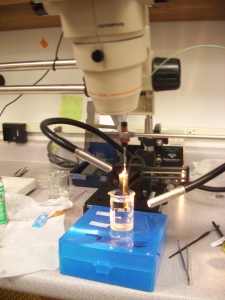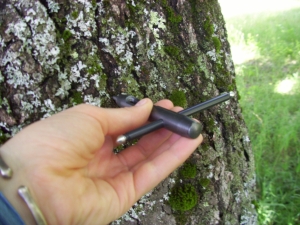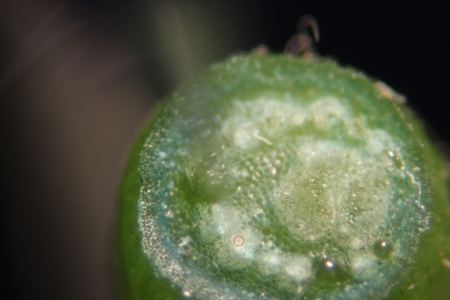You are here
Some Important Small Things
Mass extinction. Climate Change. Drought. Buzzwords that the media has been shouting out to the world with dire predictions of impending doom. Words that seem too large and far away to fit into our daily lives. My study at the Harvard Forest aims to shed light on all of these things, beginning at a scale too small to see without the aid of a microscope.
Since I was a little girl, I have stood in the woods and listened to the trees whisper to each other, branches gently swaying and leaves trembling in the breeze. Now I imagine that I hear water, flowing water, water traveling up from the earth through the trees and into the sky, as evaporation from the leaves pulls it up from the soil and through a network of conduits within the tree. These conduits, known as xylem, can be damaged if the evaporative pull becomes too strong, such as in the especially hot and dry conditions of a drought.
 Damage to the xylem occurs when the force of the pull is strong enough to break the end wall of the xylem and pull air into the conduit. Little is known as to how resistant different New England tree species are to this damage, and it is also unknown whether trees alter their patterns of xylem development in response to weather conditions. With climate models predicting increased drought frequencies, this information is especially relevant today.
Damage to the xylem occurs when the force of the pull is strong enough to break the end wall of the xylem and pull air into the conduit. Little is known as to how resistant different New England tree species are to this damage, and it is also unknown whether trees alter their patterns of xylem development in response to weather conditions. With climate models predicting increased drought frequencies, this information is especially relevant today.
My work is to determine the pressure at which damage occurs in the root, trunk, branch, and leaf petiole tissue of two well-known New England tree species: red maple and red oak. I can typically be found in the lab at Harvard Forest, peering through a microscope as I attempt to insert the point of a hollow glass needle into an individual xylem vessel of a twig half-submerged in a glass of water. The other end of the hollow needle is connected to a tank of pressurized nitrogen. When I open the valve, the pressure entering the stem gradually increases until an end wall in the xylem vessel breaks. The air rushing through the conduit becomes visible as a tiny stream of bubbles emerging from the submerged end of the twig. The pressure at which this occurs is often over 500 psi, more than seven times the pressure held in a typical bike tire.
 At the start of each week, I can also be found wandering through the forest and tripping over branches as I seek the twenty-one trees whose growth I am tracking over the course of the summer. I am not particularly interested in measures of total growth such as diameter or height. I am interested in the new xylem they are forming this summer. I gently tap a small instrument known as a micro-corer into each tree and remove a miniscule cylinder of wood containing the most recent growth. Comparisons of measurements of its structure with weather data will make it possible to determine if tree alter their patterns of xylem development in response to weather conditions.
At the start of each week, I can also be found wandering through the forest and tripping over branches as I seek the twenty-one trees whose growth I am tracking over the course of the summer. I am not particularly interested in measures of total growth such as diameter or height. I am interested in the new xylem they are forming this summer. I gently tap a small instrument known as a micro-corer into each tree and remove a miniscule cylinder of wood containing the most recent growth. Comparisons of measurements of its structure with weather data will make it possible to determine if tree alter their patterns of xylem development in response to weather conditions.
Small-scale measurements of things too tiny to see clearly with the naked eye add up to paint a much broader picture. Our data will help predict how important tree species may respond to the changing climate, indicating the likelihood that they will adjust, continue as normal, or decline in this region.


